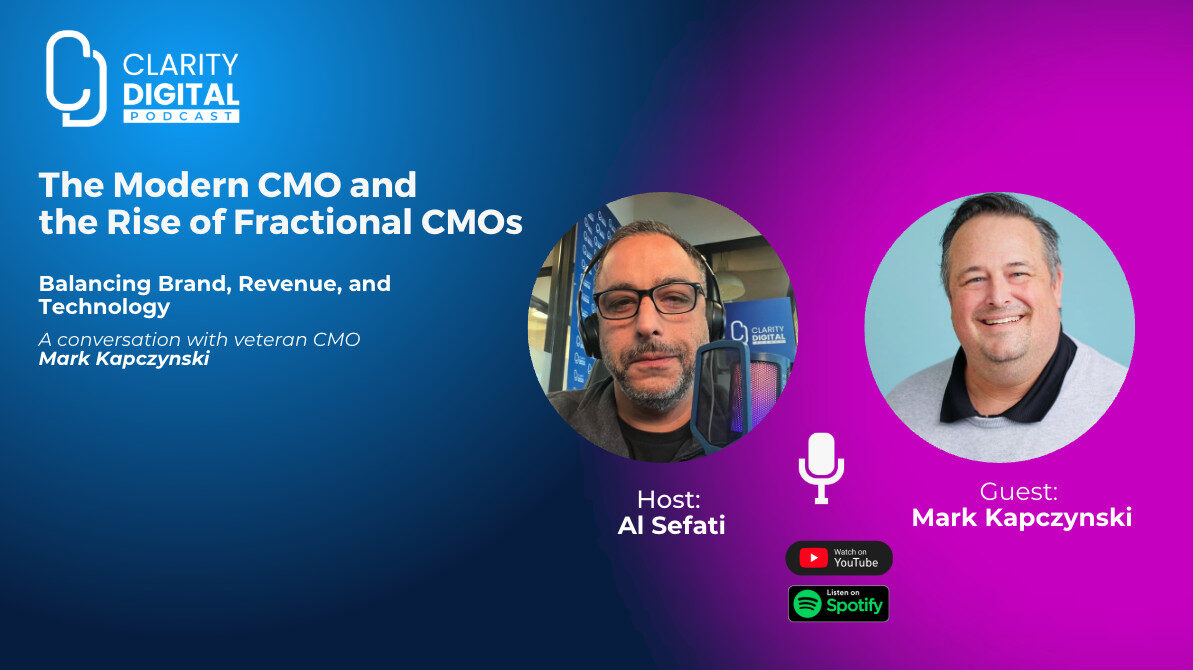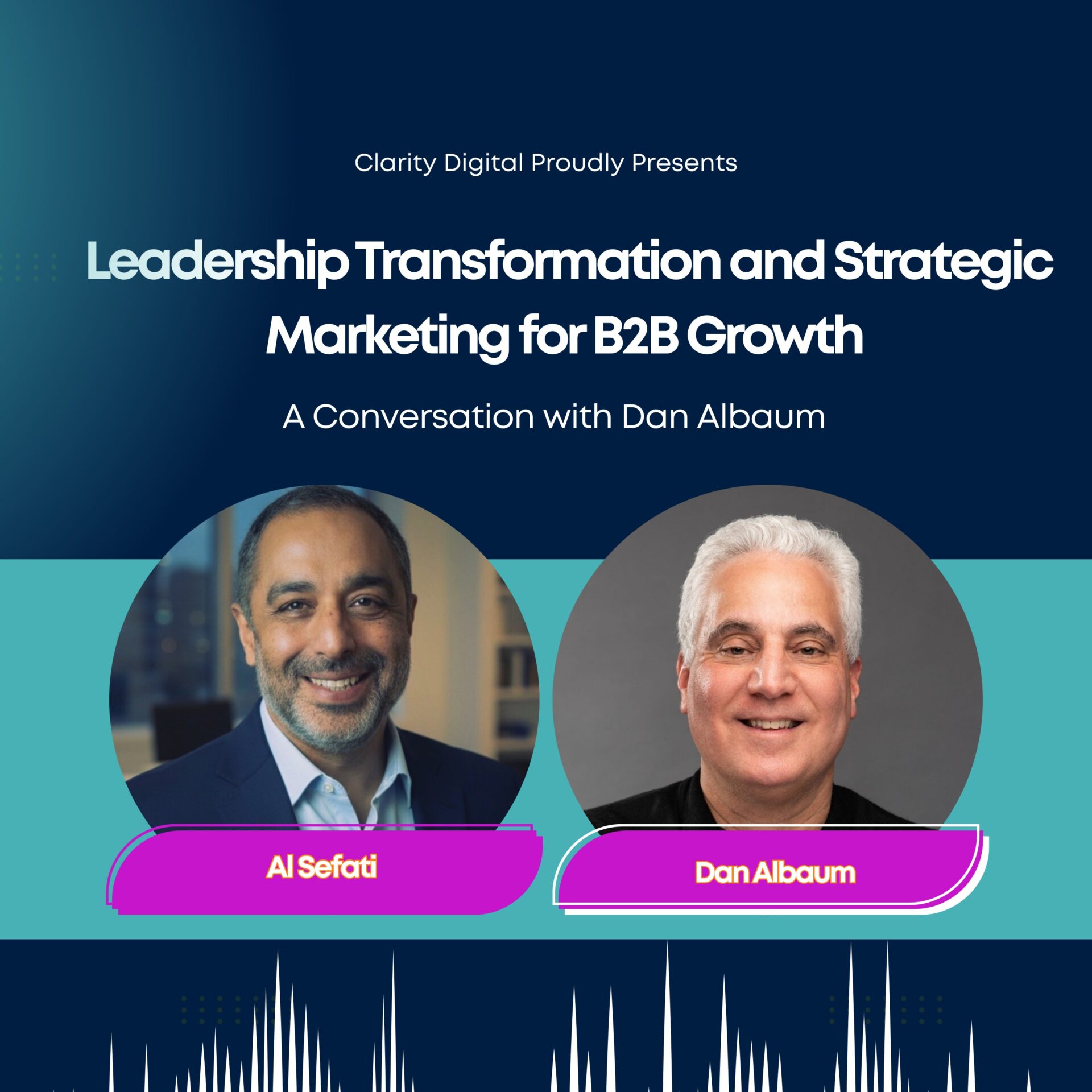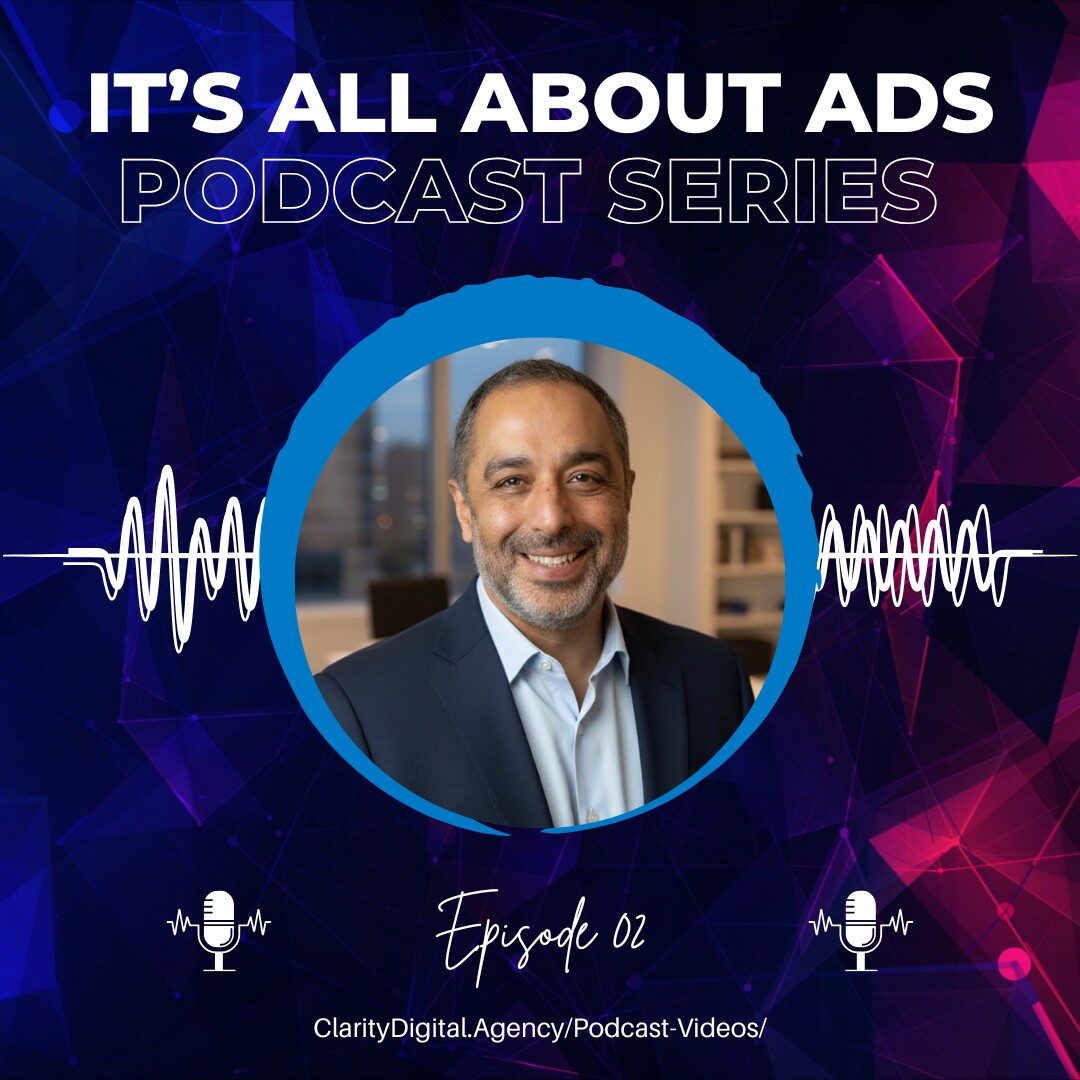Balancing Brand, Revenue, and Technology
A conversation with veteran CMO Mark Kapczynski
Welcome back to the Clarity Digital Pod blog! I’m Al Sefati, your host and founder of this digital marketing-focused podcast. Recently, I had the pleasure of hosting Mark Kapczynski once again—a seasoned marketing leader with extensive experience across multiple industries, from consumer credit and financial services to renewable energy and beyond. Mark has been a full-time CMO and has also served in fractional CMO roles, affording him a unique perspective on how marketing executives can drive revenue, manage branding, and leverage modern technology to deliver measurable results.
During our conversation, we touched on a variety of topics essential for today’s marketing leaders. We discussed the primary responsibilities of a CMO, the growing popularity of the fractional CMO role, collaboration between marketing teams and external partners (including CMO agency support), how artificial intelligence (AI) is transforming marketing, and how modern CMOs can thrive by embracing broad skill sets. In this long-form summary, you’ll get a comprehensive look at Mark’s insights and why they matter for businesses large and small.
Grab a coffee, settle in, and discover what it means to be an effective CMO in today’s rapidly evolving landscape—and why a fractional CMO or CMO agency may be the right fit for many organizations.
The Evolving Role of the CMO
1. A Dual Mandate: Brand and Revenue
One of the most critical ideas that emerged during our conversation is that the modern CMO has a dual mandate: build the brand and drive revenue. While marketing historically has been seen as primarily responsible for brand awareness, modern companies now also expect their marketing leaders to be directly accountable for profitable growth.
Mark pointed out that successful CMOs understand this balance. While branding builds long-term awareness and equity, revenue-oriented campaigns keep the lights on and demonstrate a clear return on investment (ROI). Without a healthy balance between brand and revenue-focused initiatives, companies often struggle to justify marketing budgets or measure the true impact of their marketing activities.
2. The Rise of Accountability
In the past, some executives might have viewed marketing as a “cost center,” where budgets were allocated to large creative campaigns without clear tracking of how (or if) they contributed to sales. However, Mark emphasized that modern CMOs have to be far more accountable. Digital technology, especially within performance marketing, has made it easier to track how every dollar spent contributes to leads, conversions, and eventually revenue.
Of course, not every marketing investment yields immediate revenue—some initiatives serve to build brand strength over the long haul. But overall, accountability remains essential. A forward-thinking CMO will align closely with finance teams, ensuring budgets are allocated strategically to both short-term and long-term marketing programs.
3. Collaborating with Multiple Stakeholders
The CMO role doesn’t exist in a vacuum. Mark stressed the importance of working collaboratively with product teams, customer service, sales, and other departments. This holistic approach helps ensure that branding messages are accurate, marketing materials reflect actual product benefits, and customer feedback loops from support are used to refine both product and messaging.
However, this level of collaboration typically requires an organizational culture that values transparency and cross-functional teamwork. If a CEO puts up “walls” between marketing and other departments, the CMO will have an uphill battle—one that could lead to lackluster performance and short tenure. In Mark’s view, a marketing leader should be integrated into the company’s larger goals from day one, leading to a more cohesive brand experience and a clear path to revenue.
The Emergence of the Fractional CMO
1. Why Fractional CMOs Are on the Rise
A significant topic in our discussion was the growing popularity of the fractional CMO model. A fractional CMO is a marketing executive who works part-time or on a contract basis with a company, offering strategic expertise without the cost or commitment of a full-time CMO hire. This arrangement is especially appealing to small and mid-sized businesses, or startups that are in growth mode but can’t justify the salary and overhead associated with a full-time chief marketing officer.
Mark, who has served as a fractional CMO, explained how this model enables companies to “right-size” their marketing leadership. Some businesses have a limited scope of marketing projects, so they don’t require a full-time executive. Others might have robust marketing needs but want a specialized marketing leader with certain expertise (say, in AI-driven digital marketing or brand repositioning) for a finite period.
2. Fractional CMO vs. Traditional CMO
A common question is how a fractional CMO differs from a traditional, full-time CMO. Structurally, there’s not much difference in the role’s responsibilities. Both are tasked with building brand equity, strategizing marketing campaigns, overseeing budgets, and driving profitable growth. The main distinction is time and scope. A fractional CMO might dedicate a set number of hours or days each week to a company, and their compensation aligns with that limited engagement.
Additionally, a fractional CMO often helps businesses with broad digital transformation. Since technology changes rapidly, some companies prefer a flexible approach, tapping into high-level marketing expertise only when they need it. This nimble structure can be particularly beneficial as AI-based tools and new marketing channels rapidly emerge.
3. The Best Fit for Fractional CMO Engagements
During the podcast, we discussed how fractional CMOs often work closely with CMO agencies or consultant teams to handle specific functions such as performance marketing, SEO, social media management, and creative development. If the company in question is small or mid-sized, it might not have the budget or immediate need to employ multiple full-time specialists. A fractional CMO can coordinate outsourced or agency-based workstreams and ensure it all aligns with the brand vision.
Furthermore, Mark pointed out that fractional roles can also work in larger companies—particularly if they’re going through a transition period or need to rapidly develop a specific segment of marketing (e.g., e-commerce or branding during a re-launch). In these cases, the fractional CMO provides executive-level oversight, freeing full-time leadership to focus on core business activities.
Partnering with a CMO Agency
1. Why Agencies Still Matter
Even with a strong in-house marketing team or a fractional CMO, there’s a growing need for specialized agencies—often referred to as CMO agencies—that can provide domain expertise in areas like performance marketing, branding, web development, or advanced analytics. These agencies stay up-to-date on the latest technology, tools, and trends, and they can scale quickly based on project requirements.
Mark highlighted that a key part of the modern CMO’s skill set is knowing what to outsource versus what to keep in-house. The best CMOs build strong relationships with outside specialists, ensuring they work cohesively with internal teams. It’s crucial not to treat agency partners as adversaries or mere vendors. Rather, the most effective collaborations happen when agencies, contractors, and internal staff all operate as one united team.
2. Selecting the Right Agency for Your Needs
For companies that don’t have the time or bandwidth to manage multiple agency relationships, a single CMO agency with a broad suite of services can be the perfect fit. Alternatively, if a company requires very advanced or niche expertise, a best-of-breed approach—multiple specialized agencies managed by a fractional CMO—might be more beneficial.
Regardless of the approach, Mark emphasized the importance of establishing KPIs and communication protocols from the start. Agencies thrive when they have a clear understanding of the company’s goals, brand guidelines, and performance metrics. Regular check-ins, open lines of communication, and a shared dashboard for reporting can all ensure that collaboration remains productive and transparent.
Driving Revenue: The Heart of Modern Marketing
1. Performance vs. Brand Marketing
From Mark’s perspective, the false dichotomy between performance marketing and brand marketing has to go. Too often, companies say, “This is our brand budget, and that is our performance budget,” treating them as though they operate in completely separate silos. But in reality, brand-focused campaigns often have performance metrics (like site traffic, leads, or direct sales conversions) and performance campaigns benefit from strong brand equity to drive better click-through and conversion rates.
A modern CMO or fractional CMO must understand how to orchestrate these elements seamlessly. By tracking both brand health (think brand awareness, sentiment, and share of voice) and direct response metrics (clicks, conversions, sales), a marketing leader can optimize spend across multiple channels without sacrificing brand integrity.
2. Retention Marketing: An Overlooked Opportunity
Another element of driving revenue that marketers sometimes overlook is retention. Companies frequently focus on customer acquisition but fail to invest in strategies that keep current customers loyal. Mark shared how the CMO or fractional CMO must work with product and customer success teams to develop retention campaigns, loyalty programs, and upsell opportunities.
First-party data is key to effective retention. Understanding buying patterns, support tickets, and past interactions can give marketers the insight needed to create personalized re-engagement campaigns. Instead of trying to force brand messages onto new prospects, a significant revenue opportunity often lies in nurturing relationships with those who already know and trust your brand.
3. Demonstrating Marketing ROI
Demonstrating ROI remains a central priority. While certain branding efforts may take time to pay off, the modern CMO ensures that there’s always a method of quantifying success over specific intervals. This could involve setting up multi-touch attribution models, building dashboards that track customer lifetime value (LTV), or leveraging metrics like Net Promoter Score (NPS) to gauge the quality of customer experiences.
Ultimately, the CMO or fractional CMO needs to tie data from advertising, CRM platforms, e-commerce, and other sources into a cohesive narrative. This narrative should explain how marketing initiatives lead to tangible outcomes, thus reinforcing the marketing department’s contributions to overall company growth and health.
Embracing Technology: AI as a Marketing Tool
1. AI as Automation vs. AI as Magic
In our conversation, we examined how AI is simultaneously changing “everything and nothing” in marketing. While AI holds tremendous promise—from generating copy to optimizing media buys—many of the tasks that AI tools handle are essentially automations of repetitive workflows, data analysis, or personalization. Mark underscored that AI still needs informed oversight.
A chief marketing officer (or fractional CMO) must ensure that the data going into AI systems is correct and that the automated outputs actually align with brand guidelines. AI can produce misinformation or off-brand messaging if not carefully guided. Therefore, the marketing leader’s role is to incorporate AI in a responsible manner—treating it as a powerful tool for efficiency rather than a magic bullet that replaces human expertise.
2. Personalizing Customer Experiences
AI’s greatest impact might be in personalization at scale. From chatbots that handle preliminary customer support interactions to advanced recommendation engines that show customers relevant products or content based on browsing behavior, AI can greatly enhance the customer journey. This level of personalization can boost conversion rates and strengthen brand loyalty, leading to higher lifetime value and better word-of-mouth.
However, Mark reiterated the crucial role of the CMO in providing the strategic vision: deciding which aspects of the customer experience should be automated versus which should remain human-driven. For instance, high-value customers might still need the personal touch of a human sales rep. Proper segmentation is key, and AI can help identify the right customers for the right level of human interaction.
3. Scaling Content and Testing
One practical way marketers are using AI today is content creation and testing. Tools powered by AI can generate multiple variants of ad copy, email subject lines, or landing page designs in a fraction of the time a human team would need. Then, these variants can be tested rapidly to identify the highest performing approach.
A modern CMO or fractional CMO can capitalize on this by running more frequent experiments across channels—something that was historically resource-intensive. Nonetheless, Mark cautioned that AI-driven experimentation still requires a skilled marketing leader to review outputs, ensure brand consistency, and verify the accuracy of any data presented by AI systems.
Key Skills for Aspiring CMOs
1. A Broad and Adaptable Skill Set
For those looking to become a CMO—or a fractional CMO—Mark stressed the importance of developing both depth and breadth. Depth involves mastering a particular domain like SEO, brand management, or performance advertising. Breadth means understanding enough of every other marketing function to know how it all fits together.
This parallels Mark’s background: he worked in various sectors, learned about customer data, ventured into brand work, and delved into performance marketing. By gaining experience in multiple functional areas, one can lead teams more effectively, evaluate agency proposals with a critical eye, and foresee industry shifts before they become disruptive.
2. Continuous Learning and Curiosity
Beyond technical or domain-specific expertise, modern CMOs must be lifelong learners. Marketing and technology change too rapidly for any leader to rely on “what worked five years ago.” Whether it’s taking online courses, attending conferences, or regularly listening to industry podcasts, a CMO must stay curious about new channels, consumer behaviors, data privacy regulations, and emerging AI tools.
Mark pointed out that CEOs now demand marketing leaders who can pivot quickly, manage crises (such as significant market shifts or pandemics), and capitalize on new opportunities almost in real-time. Having a learning mindset is a clear differentiator in a market flooded with executives who are used to old methods and slow to adapt.
3. Relationship Building and Communication
Despite all the technological advances, marketing remains a human-centered discipline. A CMO doesn’t work in isolation; they need to bring together product managers, finance executives, agencies, contractors, and more. Persuading colleagues to adopt new strategies or invest in new channels hinges on effective communication and trust-building.
Mark underscored that if leadership teams, employees, and external partners are all aligned with the marketing vision, campaigns are far more successful. This alignment typically requires listening skills, empathy, and the ability to foster collaboration. Whether you’re a fractional CMO splitting time between multiple clients or a full-time executive at a global corporation, communication and stakeholder buy-in are fundamental to achieving marketing objectives.
Challenges and Trends Impacting CMOs
1. Short Tenure in the C-Suite
It’s well-documented that CMOs often face some of the shortest tenures in the C-suite. Mark mentioned that some are let go when their brand-focused campaigns fail to deliver revenue growth, while others might move on quickly to become CEOs themselves or transition to new ventures. This volatility underscores the importance of tying every marketing initiative to business outcomes.
A company might invest heavily in brand-building, only to abandon the effort if immediate sales don’t follow. Conversely, a fractional CMO arrangement might protect both parties from long-term misalignment, allowing for a lower-risk exploration of new marketing directions. Regardless, the CMO must demonstrate quick wins alongside crafting a sustainable long-term strategy.
2. Organizational Silos
Organizational structures can also hinder a CMO. In some companies, product teams, sales teams, and marketing teams don’t effectively share information, leading to miscommunication or duplicated efforts. Mark stressed that CMOs should be integrators—pushing for data sharing, unified tech stacks, and cross-department initiatives. If you’re a fractional CMO, you may face an even steeper challenge because you’re stepping into a company without the traditional leverage a full-time executive might have.
Nevertheless, tearing down silos is vital. Not only can the cross-pollination of ideas lead to better campaign outcomes, but it also fosters a culture of transparency. That culture, in turn, helps a business adapt more readily to consumer feedback and marketplace shifts.
3. The Importance of a Supportive CEO
Finally, the support of a CEO—whether for a full-time or fractional CMO—remains one of the most important factors in a CMO’s success. As Mark pointed out, if the CEO doesn’t have a clear grasp of marketing’s potential or is set on unrealistic ROI targets, the marketing leader’s job becomes nearly impossible.
A supportive CEO invests in building a strong marketing foundation and sees the CMO as a strategic partner rather than a cost center manager. When the CEO is on board with a balanced approach—combining brand growth, technology, and performance metrics—marketing initiatives gain momentum and deliver real value to the entire organization.
The Future of the Modern CMO
1. Greater Ownership of Revenue
Looking ahead, expect the CMO to take on even greater ownership of revenue. As more businesses rely on digital channels—where conversions and ROI can be measured in near real-time—the lines between marketing, sales, and product will continue to blur. In some organizations, we’re already seeing the emergence of roles like Chief Growth Officer (CGO) or a more integrated Chief Revenue Officer (CRO).
Whether a company maintains the traditional CMO title or opts for these alternatives, the impetus remains the same: tie brand-building and marketing activities to tangible financial results while protecting long-term brand integrity.
2. Expansion of Fractional CMO Opportunities
The fractional CMO model is here to stay, and it will likely expand as more companies become comfortable with flexible staffing and on-demand executive talent. This structure benefits marketers who crave variety and challenge and benefits businesses that prefer a nimble, scalable approach. These engagements also pair well with CMO agencies, especially when the fractional CMO orchestrates specialized campaign execution teams that don’t need to be on full-time payroll.
For marketers, this trend signals that there are multiple paths to executive leadership. You don’t necessarily have to become a full-time CMO at a Fortune 500 company; you can also build a career as a fractional CMO, tackling projects at different companies and driving transformation in short, impactful bursts.
3. AI and Beyond
AI will only become more ubiquitous. As the technology matures, expect advanced personalization, automated data analysis, and streamlined creative processes to become the norm. The modern CMO must embrace these tools while maintaining a healthy dose of oversight and strategic direction. The dangers of misinformation, potential brand misalignment, and algorithmic bias mean that human judgment remains critical.
In the broader sense, technology will continue to disrupt marketing. Voice-activated search, virtual and augmented reality, and blockchain-based loyalty systems are just a few of the many frontiers that could reshape marketing over the next decade. A forward-looking CMO or fractional CMO stays curious, agile, and prepared to pivot as these developments emerge.
Final Take Ways of The Modern CMO and Rise of Fractional CMOs Podcast
Our conversation with Mark Kapczynski provided a wealth of insights into the evolving world of marketing leadership. Whether you’re a budding marketer, a startup founder, or a business executive looking to hire a CMO or fractional CMO, the key takeaways can be summarized as follows:
- Brand and Revenue Go Hand in Hand: Modern CMOs must excel at both building brand equity and delivering measurable sales outcomes. This balance ensures that marketing teams are respected as revenue drivers, not just cost centers.
- The Fractional CMO Model Delivers Flexibility: As businesses face tighter budgets and need specialized expertise, the fractional CMO role is rising in popularity. This approach allows companies to bring in executive-level marketing acumen without the overhead of a full-time CMO.
- CMO Agencies Play a Crucial Role: Collaborating with specialized or full-service agencies can amplify a marketing leader’s impact. The best CMO-agency relationships treat each party as part of the same team.
- AI as a Tool, Not a Substitute for Strategy: Artificial intelligence can automate workflows, scale content creation, and personalize customer experiences, but it requires careful guidance. The CMO remains responsible for ensuring data accuracy, brand alignment, and responsible deployment.
- Continuous Learning and Cross-Functional Collaboration: Today’s CMOs must know how to adapt quickly. They should also be skilled at building trust and dismantling organizational silos, ensuring that marketing works hand-in-hand with product, finance, sales, and customer service.
- Leadership and Communication Are Vital: Ultimately, what separates effective marketing leaders from the rest isn’t just technical skill. It’s the ability to unite diverse teams, communicate vision, and gain stakeholder buy-in across the organization.
- The Future Favors Adaptable Marketers: Whether you call it a CMO role, fractional leadership, or another title entirely, the modern marketing executive must be adaptable, data-driven, collaborative, and perpetually learning.
If you’re seeking to refine your company’s approach to marketing, consider how a fractional CMO or CMO agency could bring both breadth of expertise and focus on revenue to your organization. On the flip side, if you’re an aspiring CMO yourself, deepen your skill set across disciplines, remain curious, and strive to understand how each part of the marketing ecosystem—branding, technology, performance, and customer experience—works in concert to drive meaningful, profitable growth.
Stay Tuned with Clarity Digital Pod for New Episodes & Connect with Clarity Digital Agency for Expert Fractional CMO Solutions
As the host of Clarity Digital Pod, I’m continually inspired by conversations that blend real-world experience with forward-thinking strategies. Talking with Mark reinforced my belief that marketing is both an art and a science, demanding both creativity and concrete accountability. The CMO—or fractional CMO—operates at the nexus of these forces, shaping how companies resonate with their audiences and achieve tangible business objectives.
Whether you’re leading a marketing team, starting your own business, or just exploring different approaches to digital strategy, I hope this deep dive into our conversation has shed light on what truly matters in marketing today. If you’d like to learn more, feel free to check out our latest podcast episode with Mark for additional insights and examples. And as always, stay curious, stay collaborative, and keep aiming for that perfect balance between brand and revenue.
Thank you for reading, and until next time—keep evolving and innovating in the dynamic world of marketing!




